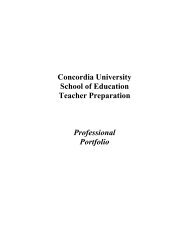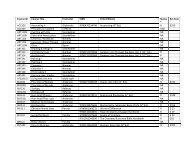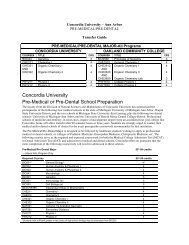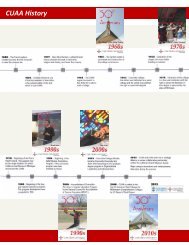2006â2007 Academic Catalog - Concordia University Ann Arbor
2006â2007 Academic Catalog - Concordia University Ann Arbor
2006â2007 Academic Catalog - Concordia University Ann Arbor
Create successful ePaper yourself
Turn your PDF publications into a flip-book with our unique Google optimized e-Paper software.
26 |<br />
ACADEMIC REGULATIONS & PROCEDURES<br />
The cumulative grade point average is calculated only on coursework taken at <strong>Concordia</strong><br />
<strong>University</strong>. In considering the admission of transfer students to teacher education, all grades,<br />
including transfer credits, may be used to evaluate major/minor/program grade point averages.<br />
Pass/No Credit<br />
In a given semester, the student may elect the pass/no credit option for any class that fits<br />
into one of the following categories: one course of 2-4 credit hours; one or more one-credit<br />
course(s). A maximum of 10 semester hours of pass/no credit courses may be included in<br />
any degree program. The pass/no credit option may not be used for any course in the student’s<br />
major, minor or program. Practicum and other courses that are available only on a<br />
pass/no credit basis, such as directed teaching, internships, fieldwork courses, field trips,<br />
and the like are not included in these limitations. The student must state his/her intention<br />
to elect the pass/no credit option to the Registrar, in writing, by the last school day of classes<br />
(excluding final exams) or the day before the last meeting of specially scheduled classes.<br />
First semester freshmen are not eligible for the pass/no credit option. An earned grade of<br />
C- or higher will result in a transcripted grade of P (PASS-credit awarded), and an<br />
earned grade of D+ or lower will result in a transcripted grade of NC (NO CREDITno<br />
credit awarded). P and NC grades do not affect the student’s grade point average.<br />
<strong>Academic</strong> Probation and Dismissal<br />
All students are expected to maintain satisfactory academic progress toward graduation. Any<br />
student with a cumulative grade point average (at the end of any semester) lower than<br />
2.0000 (C average) is placed on academic probation for the next enrolled semester. The academic<br />
probation will be noted on the student’s transcript.<br />
A student on academic probation will be required to limit his/her course load to a maximum<br />
of 14 credit hours while on probation. An accepted transfer student entering with a<br />
grade point average below 2.0000 is subject to the 14 credit hour limit. Exceptions may be<br />
granted by the Vice President of <strong>Academic</strong>s.<br />
Students who remain on academic probation for three consecutive semesters will be academically<br />
dismissed and will not be eligible to enroll in classes following the third semester.<br />
The Admissions Council may recommend that any student whose cumulative grade point<br />
average is below 1.0000 (D average) be dismissed immediately. Under exceptional circumstances,<br />
the student may appeal academic dismissal to the Admissions Council. A dismissed<br />
student may qualify for readmission on the basis of evidence of satisfactory performance in<br />
college-level work through correspondence courses, summer courses, or courses taken at<br />
another regionally accredited college. Readmission of dismissed students is the decision of<br />
the Admissions Council.<br />
Class Attendance<br />
It is expected that a student enrolled in a course will attend class regularly. Registration<br />
assumes that the student is not merely interested in receiving credit for the class but wishes<br />
to contribute to it as well. Program policies or individual faculty members can specify attendance<br />
policies and/or requirements which may affect grades.<br />
Repeating Courses<br />
Students may choose to repeat a course (once or multiple times). While all grades are maintained<br />
on the student transcript, only the most recent grade and credits earned are used in<br />
computing the grade point average and total credits earned. If a student repeats a course in<br />
which he/she earned a low passing grade and earns a higher grade, the most recent grade is<br />
used in the cumulative grade point average calculation. If a student repeats a course in<br />
which he/she earned a low passing grade in an earlier attempt and earns an F grade in a<br />
subsequent attempt, then the F grade is the most recent attempt and is used in the cumulative<br />
grade point average calculation and the student loses the credit.












